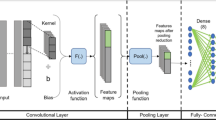Abstract
Photovoltaic (PV) energy is a renewable and permanent source of electricity available all the time. Nowadays, the solar energy integration presents an active research area due to its random and intermittent behavior. In fact, PV power prediction is valuable because it avoids complex mathematical modeling to calculate the output of a PV generator, and solves the problem of weather data uncertainty characterized by the future’s ignorance. To this goal, we present in this paper a novel solar power prediction model based on stacked Bidirectional Long-Short Term Memory (BiLSTM) deep learning model and the Extreme Learning Machine algorithm (ELM). The BiLSTM is used to predict each input weather data that affect directly the output PV power (radiation, temperature, humidity and wind speed). Then, an improved ELM algorithm is proposed and served as the main prediction model that forecast the next PV power generated based on the predicted weather data. Real data is used in this paper to test the effectiveness of the proposed prediction model whose superiority is proved through the test period. The forecasting model better performs compared to other related algorithms designed to the prediction of produced PV power.




Similar content being viewed by others
References
Chawla R, Singhal P, Garg AK (2018) Design and modelling of G-ZnO nanocomposite electrode for a-Si:H/µc-Si: H micromorph solar cell. Int J Inf Tecnol 10:265–277. https://doi.org/10.1007/s41870-017-0043-6
Bourakadi DE, Yahyaouy A, Boumhidi J (2021) Improved extreme learning machine with AutoEncoder and particle swarm optimization for short-term wind power prediction. Neural Comput Appl. https://doi.org/10.1007/s00521-021-06619-x
Bourakadi DE, Yahyaouy A (2018) Boumhidi, multi-agent system based on the extreme learning machine and fuzzy control for intelligent energy management in microgrid. J Intell Syst 29:877–893. https://doi.org/10.1515/jisys-2018-0125
Praynlin E, Jensona JI (2017) Solar radiation forecasting using artificial neural network. In: 2017 Innovations in power and advanced computing technologies (i-PACT), avr. p. 1–7. https://doi.org/10.1109/IPACT.2017.8244939
Cao J, Lin X (2008) Study of hourly and daily solar irradiation forecast using diagonal recurrent wavelet neural networks. Energy Conversion Manag 49(6):1396–1406. https://doi.org/10.1016/j.enconman.2007.12.030
Suyono H, Santoso H, Hasanah RN, Wibawa U, Musirin I (2018) Prediction of solar radiation intensity using extreme learning machine. Indonesian J Electrical Eng Comput Sci. https://doi.org/10.11591/ijeecs.v12.i2.pp691-698
SOLAR PHOTOVOLTAIC OUTPUT POWER FORECASTING USING BACK PROPAGATION JB (2016) NEURAL NETWORK. ICTACT J Soft Comput 06:1144–1152. https://doi.org/10.21917/ijsc.2016.0159
Bourakadi DEL, Yahyaouy A, Boumhidi J (2019) Multi-agent system based sequential energy management strategy for Micro-Grid using optimal weighted regularized extreme learning machine and decision tree. Intell Decision Technol 13:479–494. https://doi.org/10.3233/IDT-190003
Buwei W, Jianfeng C, Bo W, Shuanglei F, et al (2018) A solar power prediction using support vector machines based on multi-source data fusion. In: International Conference on Power System Technology (POWERCON) p. 4573–4577. https://doi.org/10.1109/POWERCON.2018.8601672
Bhattacharya T, Chakraborty AK, Pal K (2014) Effects of ambient temperature and wind speed on performance of monocrystalline solar photovoltaic module in Tripura, India. J Solar Energy. https://doi.org/10.1155/2014/817078
Annamalai R, Nedunchelian R (2022) Design of optimal bidirectional long short term memory based predictive analysis and severity estimation model for diabetes mellitus. Int J Inf Tecnol. https://doi.org/10.1007/s41870-022-00933-w
Zheng J et al (2020) Time series prediction for output of multi-region solar power plants. Applied Energy 257
Ozoegwu CG (2019) Artificial neural network forecast of monthly mean daily global solar radiation of selected locations based on time series and month number. J Clean Prod 216:1–13. https://doi.org/10.1016/j.jclepro.2019.01.096
Sharma N et al (2021) A sequential ensemble model for photovoltaic power forecasting. Comput Electr Eng 96:107484. https://doi.org/10.1016/j.compeleceng.2021.107484
Bourakadi DE, Yahyaouy A, Boumhidi J (2022) Intelligent energy management for micro-grid based on deep learning LSTM prediction model and fuzzy decision-making. Sustain Comput
Meshram S, Anand Kumar M et al (2021) Long short-term memory network for learning sentences similarity using deep contextual embeddings. Int J Inf Tecnol 13(4):1633–1641. https://doi.org/10.1007/s41870-021-00686-y
Chhachhiya D, Sharma A, Gupta M et al (2019) Designing optimal architecture of recurrent neural network (LSTM) with particle swarm optimization technique specifically for educational dataset. Int J Inf Tecnol 11(1):159–163. https://doi.org/10.1007/s41870-017-0078-8
Wang Z, Wang F, Su S (2011) Solar irradiance short-term prediction model based on BP neural network. Energy Proc 12:488–494. https://doi.org/10.1016/j.egypro.2011.10.065
Shadab A, Ahmad S, Said S (2020) Spatial forecasting of solar radiation using ARIMA model. Remote Sens Appl 20
Zhu T, Li Y, Li Z, Guo Y, Ni C et al (2022) Inter-hour forecast of solar radiation based on long short-term memory with attention mechanism and genetic algorithm. Energies. https://doi.org/10.3390/en15031062
Author information
Authors and Affiliations
Corresponding author
Additional information
Publisher’s Note
Springer Nature remains neutral with regard to jurisdictional claims in published maps and institutional affiliations.
Rights and permissions
Springer Nature or its licensor (e.g. a society or other partner) holds exclusive rights to this article under a publishing agreement with the author(s) or other rightsholder(s); author self-archiving of the accepted manuscript version of this article is solely governed by the terms of such publishing agreement and applicable law.
About this article
Cite this article
El Bourakadi, D., Ramadan, H., Yahyaouy, A. et al. A novel solar power prediction model based on stacked BiLSTM deep learning and improved extreme learning machine. Int. j. inf. tecnol. 15, 587–594 (2023). https://doi.org/10.1007/s41870-022-01118-1
Received:
Accepted:
Published:
Issue Date:
DOI: https://doi.org/10.1007/s41870-022-01118-1




